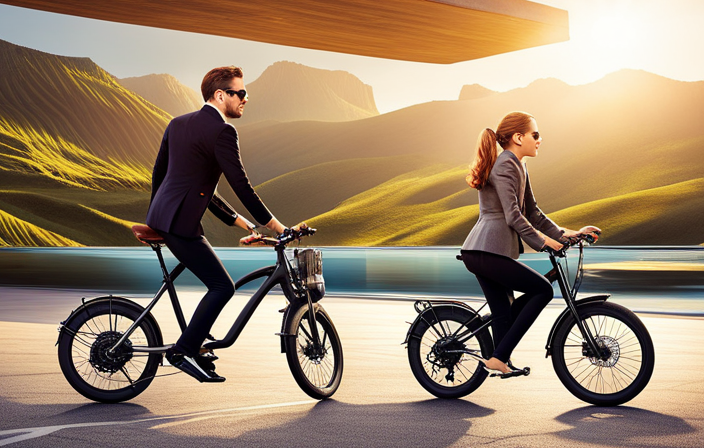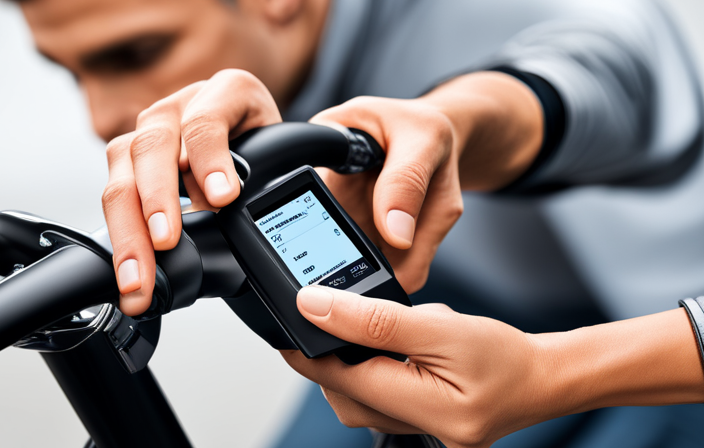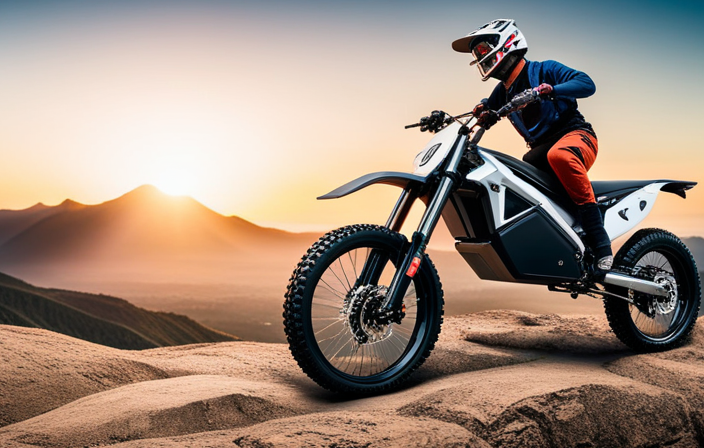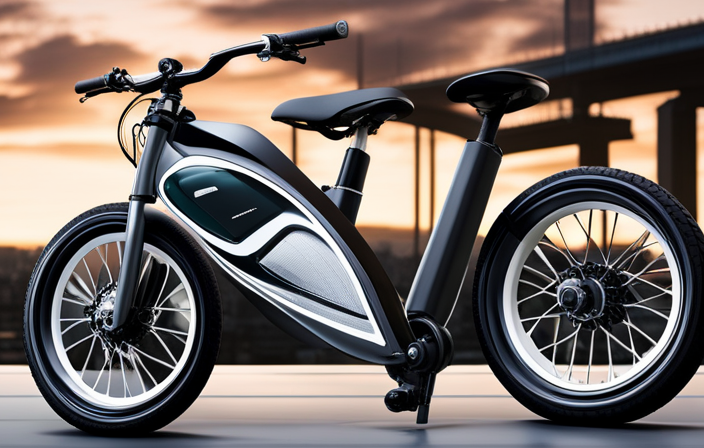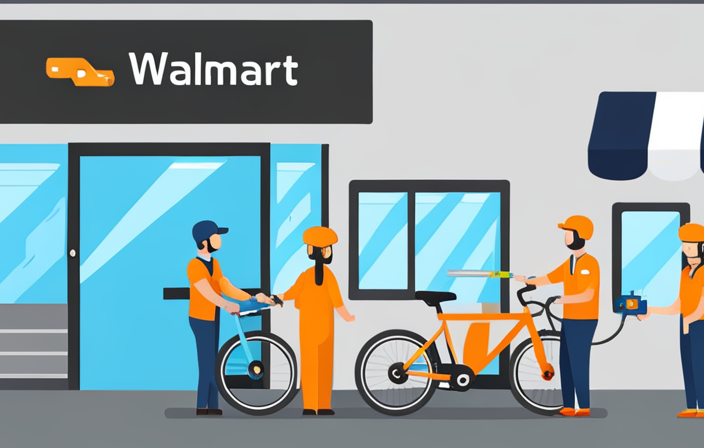As an avid cyclist, I know the exhilaration of exploring the open road on an electric bike. But as much as I love the ride, I also understand the importance of keeping my bike fully charged.
That’s why I’m here to share with you the ins and outs of charging an Ancheer electric bike. From checking the battery level to finding the perfect charging spot, I’ll guide you through the process step by step.
So, let’s dive in and ensure your electric bike is always ready for your next adventure.
Key Takeaways
- Familiarize yourself with the components and features of your Ancheer electric bike
- Maintain the battery by keeping it clean, dry, and charging it regularly
- Check the battery capacity on the display panel and plan rides accordingly
- Find a suitable charging location and consider using dedicated charging stations or public places with outdoor outlets
Understanding Your Ancheer Electric Bike
To understand your Ancheer electric bike, you’ll need to familiarize yourself with its different components and features. One important aspect to consider is the charging efficiency of the bike’s battery.
The battery is a crucial component that powers your electric bike, so it’s essential to maintain it properly. To maximize charging efficiency, always use the charger that came with your bike and plug it into a standard electrical outlet. Avoid using extension cords or power strips, as they may affect the charging process.
Additionally, ensure that the battery is properly maintained by keeping it clean and dry, avoiding extreme temperatures, and charging it regularly. By following these guidelines, you can ensure the longevity and optimal performance of your Ancheer electric bike’s battery.
Now, let’s move on to checking the battery level.
Check the Battery Level
First, make sure the battery level of your e-bike is checked. This is crucial in order to effectively charge your Ancheer electric bike. To check the battery capacity, locate the display panel on the handlebar. It will show the remaining battery power, usually indicated as a percentage.
By regularly checking the battery level, you can plan your rides accordingly and avoid running out of power during your journey. Additionally, keeping an eye on the battery level allows you to extend its life. Lithium-ion batteries, commonly used in e-bikes, perform best when kept between 20% and 80% charge. Overcharging or letting the battery drain completely can shorten its lifespan.
By maintaining a healthy battery level, you can ensure longer rides and a more enjoyable e-bike experience.
Now, let’s find a suitable charging location.
Find a Suitable Charging Location
Now that you know the battery level of your e-bike, it’s time to find a suitable charging location. Here are three tips to help you in this process:
-
Look for charging station availability: Check if there are any dedicated charging stations in your area. These stations are specifically designed to charge electric vehicles, including e-bikes. They usually offer faster charging speeds and have multiple charging ports available.
-
Consider public places: Look for public places like parks, shopping centers, or libraries that have outdoor outlets. These outlets can be used to charge your e-bike, but make sure to bring your own charger and cable.
-
Optimize charging time: If you have a long journey ahead, plan your charging stops strategically. Look for locations where you can charge your e-bike while taking a break, such as restaurants or cafes. This way, you can make the most of your time and ensure that your e-bike is fully charged when you continue your journey.
Now that you’ve found a suitable charging location, it’s time to connect the charger and get your e-bike charging.
Connect the Charger
To charge my Ancheer e-bike, the first step is to locate the charging port. On my particular model, the charging port is located near the base of the frame, usually on the side or underneath.
Once I find the charging port, I simply plug in the charger securely, making sure it is firmly connected to the charging port. It’s important to ensure a snug fit to prevent any accidental disconnections during the charging process.
Locate the charging port on your Ancheer e-bike
You’ll want to find the charging port on your Ancheer e-bike. The charging port is an essential component for recharging the battery of your electric bike.
To locate the charging port, follow these steps:
- Look for a small, rectangular flap on the frame of your e-bike.
- Open the flap to reveal the charging port.
- The charging port is usually located near the battery or on the side of the frame.
- It is typically labeled with a charging symbol or the word ‘CHARGE.’
Once you have located the charging port, you can proceed to plug in the charger securely. This step is crucial to ensure a proper connection and prevent any charging issues.
Plug in the charger securely to the charging port
Make sure to firmly connect the charger to the charging port to ensure a secure and reliable charging process.
When plugging in the charger, it is essential to ensure a proper connection between the charger and the charging port of your Ancheer electric bike. This step is crucial for the charging process to initiate correctly.
Once connected, you can start monitoring the charging indicators on your bike’s display or the charger itself. Understanding these indicators is vital as they provide valuable information about the charging status, such as battery level and charging progress.
In case you encounter any issues with the charger compatibility, it is advisable to check if the charger is compatible with your specific model of Ancheer electric bike.
Now that the charger is securely connected, let’s move on to the next section where we will learn how to monitor the charging process.
Monitor the Charging Process
Keep an eye on the charging process of your ancheer electric bike to ensure it is progressing smoothly. Troubleshooting charging issues can be a frustrating task, but it is essential for maintaining the battery’s health and longevity.
One common issue is a slow or non-existent charge. In this case, check if the charger is securely plugged into the bike’s charging port. Sometimes, the charging port can become loose or damaged, preventing a proper connection. Additionally, make sure the charger is functioning correctly by checking if the LED indicator light is on.
If you encounter any issues during the charging process, consult the user manual or contact the manufacturer for further assistance. By regularly monitoring the charging process and addressing any potential issues, you can ensure the optimal performance and durability of your electric bike’s battery.
When it comes to charging your ancheer electric bike, it’s important to remember a few safety precautions.
Safety Precautions
When it comes to charging my e-bike, I always make sure to follow safety precautions.
One important tip is to avoid charging the battery near any flammable materials, as this can pose a serious fire hazard.
Additionally, I never leave my charging e-bike unattended, as it is crucial to monitor the process and ensure everything is running smoothly.
Avoid charging the battery near flammable materials
Ensure you don’t charge the battery of your Ancheer electric bike near any flammable materials. Charging safety is of utmost importance when it comes to electric bikes.
To avoid any potential accidents, it is crucial to choose a safe and appropriate location for charging. Find a well-ventilated area away from any flammable substances such as gasoline, propane, or chemicals. This will reduce the risk of fire or explosion.
Additionally, proper battery storage is essential for charging safety. Store the battery in a cool and dry place, away from direct sunlight and extreme temperatures. This helps maintain the battery’s lifespan and prevents any potential damage.
Now, let’s move on to another crucial safety aspect: never leave the charging e-bike unattended.
Never leave the charging e-bike unattended
It’s important to never leave your e-bike charging unattended. Charging your e-bike safely is crucial to prevent battery damage and ensure its longevity. Here are five key charging safety precautions to keep in mind:
- Avoid overcharging: Always check the manufacturer’s recommended charging time and avoid leaving your e-bike plugged in for longer than necessary.
- Use the right charger: Using a charger specifically designed for your e-bike model is essential to prevent damage to the battery.
- Keep it away from flammable materials: Be cautious and charge your e-bike in a safe, well-ventilated area away from any potential fire hazards.
- Regularly inspect the charging cables: Ensure that the cables are in good condition and free from any signs of wear and tear.
- Follow the manufacturer’s instructions: Always refer to the manual for specific charging guidelines and any additional safety precautions.
By following these charging safety measures, you can protect your e-bike’s battery and enjoy many worry-free rides.
Now, let’s move on to some useful charging tips to further enhance your e-bike charging experience.
Charging Tips
To prolong battery life, make sure you don’t overcharge your Ancheer electric bike. Charging your e-bike properly is crucial for maintaining the battery’s health and maximizing its lifespan. Here are some charging tips to keep in mind:
- Use the original charger that came with your Ancheer electric bike.
- Plug the charger directly into a wall outlet instead of using an extension cord.
- Avoid charging your bike in extreme temperatures, as it can affect the battery’s performance.
- Don’t leave your bike plugged in for an extended period after it has reached 100% charge.
Following these tips will not only help preserve the battery life but also ensure efficient charging speed and optimal battery care.
Now, let’s move on to troubleshooting common issues that you might encounter with your Ancheer electric bike.
Troubleshooting Common Issues
When it comes to charging problems with electric bikes, such as loose connections or faulty chargers, it’s important to have a troubleshooting plan in place. Learning how to identify and address these issues can save you time and frustration.
However, if you encounter persistent charging issues that you can’t resolve on your own, it’s always best to seek professional assistance to ensure the problem is properly diagnosed and fixed.
Learn how to troubleshoot charging problems such as loose connections or faulty chargers
If you’re experiencing issues with charging your Ancheer electric bike, you can troubleshoot common problems like loose connections or faulty chargers. Here are some steps you can take to troubleshoot charging problems and ensure a safe charging process:
-
Check the power source: Make sure the power outlet you’re using is working properly and providing a consistent power supply.
-
Inspect the charging cable: Look for any signs of damage or fraying on the charging cable. If you notice any issues, replace the cable with a new one.
-
Examine the charging port: Ensure that the charging port on your bike is clean and free from debris. Use a soft cloth or a small brush to gently clean it if necessary.
Remember to always follow these safety precautions while troubleshooting and charging your Ancheer electric bike:
-
Unplug the charger when not in use.
-
Avoid charging the bike in extreme temperatures.
-
Do not overcharge the battery.
If you encounter persistent charging issues, it is recommended to seek professional assistance to avoid further damage to your bike’s charging system.
Seek professional assistance if you encounter persistent charging issues
If persistent charging issues continue, it’s best to get professional assistance to avoid further damage. Charging troubleshooting can be a complex process, and it’s important to have someone with expertise to diagnose and fix the problem.
They can identify whether the issue lies with the charger, the battery, or any other component of the charging system. A professional will have the necessary tools and knowledge to ensure a safe and effective repair. Additionally, they can provide valuable advice on battery maintenance, such as proper storage and regular cleaning.
By seeking professional assistance, you can have peace of mind knowing that your charging issues will be resolved correctly and efficiently.
Now, let’s move on to storing and maintaining the battery to maximize its lifespan.
Storing and Maintaining the Battery
When it comes to storing and maintaining the battery of my electric bike, there are a few key points to keep in mind.
Firstly, it’s important to properly store the battery when it’s not in use for extended periods of time. This means keeping it in a cool, dry place and avoiding extreme temperatures.
Secondly, following maintenance guidelines is crucial for ensuring the longevity of the battery. This includes regular cleaning, checking for any signs of damage, and adhering to the recommended charging and discharging cycles.
Properly store the battery when not in use for extended periods
To properly store your battery when not in use for extended periods, follow these guidelines:
-
Keep it in a cool and dry place. This is crucial for maximizing battery performance and ensuring its longevity. Heat and humidity can adversely affect the battery’s performance and reduce its overall lifespan.
-
Find a storage area that is away from direct sunlight, extreme temperatures, and moisture. It is recommended to store the battery at room temperature, around 68-77°F (20-25°C).
-
Make sure the battery is charged to around 50-70% before storing it. This level of charge helps maintain the battery’s health during storage.
By following these proper battery storage guidelines, you can ensure that your battery remains in optimal condition for future use.
Now, let’s discuss how to follow maintenance guidelines to ensure the longevity of your battery.
Follow maintenance guidelines to ensure the longevity of your battery
To ensure the longevity of your battery, it’s important to follow maintenance guidelines. Proper battery maintenance is crucial for maximizing battery performance and avoiding common battery issues. Here are some key maintenance practices to keep in mind:
| Maintenance Task | Frequency | Description |
|---|---|---|
| Cleaning | Monthly | Regularly clean the battery and its terminals to remove dirt and corrosion. Use a damp cloth and mild detergent if necessary. |
| Checking Voltage | Quarterly | Use a voltmeter to measure the battery’s voltage. If it falls below the recommended level, it may need to be charged or replaced. |
| Tightening | Biannually | Check the battery’s connections and tighten any loose terminals or bolts. Loose connections can lead to poor performance and potential damage. |
| Storage | Annually | If you’re not using the battery for an extended period, store it in a cool and dry place. Ensure it is fully charged before storage and periodically charge it during storage to maintain its health. |
Maximizing Battery Life
One way to maximize the battery life of your Ancheer electric bike is by avoiding frequent and abrupt acceleration. By doing so, you can maximize battery efficiency and extend the battery lifespan. When you accelerate too abruptly, it puts a strain on the battery, causing it to drain faster. Instead, try to accelerate smoothly and gradually.
Another tip for maximizing battery life is to avoid excessive uphill climbs. Uphill rides require more power from the battery, which can quickly deplete its charge. If possible, plan your routes to avoid steep inclines.
By following these guidelines, you can ensure that your Ancheer electric bike’s battery lasts longer and provides optimal performance.
Now, let’s explore the next topic: charging on the go.
Charging on the Go
If you’re on the go, finding convenient charging stations for your Ancheer electric bike can be a challenge. Luckily, there are options available that allow you to charge while riding and provide portable charging capabilities.
One option is a solar-powered charging system that can be attached to your bike. These systems use the sun’s energy to charge the battery while you ride, giving you the freedom to explore without worrying about running out of power.
Another portable option is a power bank specifically designed for electric bikes. These power banks are compact and lightweight, allowing you to easily carry them with you and charge your bike wherever you are.
With these portable charging options, you can keep your Ancheer electric bike powered up no matter where your adventures take you.
When it comes to understanding battery range, it’s important to consider factors such as terrain, weight, and riding style.
Understanding Battery Range
Understanding the battery range of an electric bike involves considering various factors such as terrain, weight, and riding style.
To maintain optimal battery performance, regular maintenance is important. This includes keeping the battery clean and dry, checking for any signs of damage, and ensuring proper storage when not in use.
When it comes to charging the battery, it is essential to follow the manufacturer’s guidelines. The charging time can vary depending on the battery capacity and the charger’s output. Typically, it takes around 4-6 hours to fully charge an electric bike battery. It is recommended to charge the battery after each ride to ensure maximum range.
By taking care of the battery and charging it properly, you can ensure a longer battery life and enjoy longer rides.
Now, let’s delve into the environmental impact of electric bikes.
Environmental Impact
Transition: Now that we have a better understanding of battery range, let’s explore the environmental impact of electric bikes.
Current Subtopic: Environmental Impact
As an eco-conscious individual, I am always on the lookout for ways to reduce my carbon footprint. This is why I am particularly drawn to electric bikes. Not only do they offer a convenient mode of transportation, but they also help minimize emissions and promote eco-friendly commuting.
To highlight the environmental benefits of electric bikes, let’s take a look at the following table:
| Gasoline Bike | Electric Bike | |
|---|---|---|
| Greenhouse Gas Emissions | High | Low |
| Air Pollution | High | Negligible |
| Noise Pollution | High | Low |
| Energy Efficiency | Low | High |
| Renewable Energy | No | Yes |
As you can see, electric bikes have significantly lower greenhouse gas emissions, air pollution, and noise pollution compared to their gasoline counterparts. They are also much more energy-efficient and can be powered by renewable energy sources, further reducing their environmental impact.
Transition: Now that we understand the positive environmental impact of electric bikes, let’s delve into the topic of charging etiquette without compromising on convenience and efficiency.
Charging Etiquette
When it comes to charging my e-bike in public spaces, I always make sure to be mindful of others. I understand that not everyone may have access to a charging station, so I try to be considerate and not hog the outlet for too long.
Additionally, I make sure to follow any specific charging guidelines or rules set by e-bike sharing programs to ensure a fair and efficient charging process for everyone involved.
Be mindful of others when charging your e-bike in public spaces
Be sure to be considerate of others when charging your e-bike in public spaces, so as not to inconvenience or obstruct them. Charging etiquette is an important aspect of using electric bikes responsibly.
When charging your e-bike, it is essential to be mindful of the environmental impact. Opt for public charging stations or designated areas where available. These spaces are specifically designed for e-bike charging and help minimize any inconvenience to others.
Additionally, make sure not to leave your bike plugged in for longer than necessary. This will allow others to use the charging station and reduce any waiting time.
It is also important to follow any specific charging guidelines or rules set by e-bike sharing programs. By adhering to these guidelines, we can ensure a smooth and efficient charging experience for everyone.
Follow any specific charging guidelines or rules set by e-bike sharing programs
It’s important to adhere to any specific charging guidelines or rules set by e-bike sharing programs to ensure a smooth and efficient charging experience for everyone. When it comes to charging your e-bike, there are a few battery charging precautions and charging speed optimization techniques that you should keep in mind:
- Always use the charger provided by the e-bike sharing program to avoid compatibility issues.
- Make sure to connect the charger securely to both the bike and the power source.
- Avoid charging the battery in extreme temperatures, as it can affect its performance and lifespan.
By following these guidelines, you can ensure the longevity of the battery and optimize its charging speed. Remember, taking care of the battery is crucial for the overall performance of the e-bike.
In the next section, we will explore additional resources and support available for e-bike users.
Now, let’s dive into the wide range of resources and support that can assist you in utilizing your e-bike to its fullest potential.
Additional Resources and Support
There’s a wide range of additional resources and support available for charging an Ancheer electric bike.
When it comes to troubleshooting issues, the company provides an extensive online knowledge base with detailed guides and FAQs. This resource can help users easily find solutions to common problems they may encounter while charging their electric bike.
Additionally, Ancheer offers customer support through various channels, including email and phone. Their dedicated support team is knowledgeable about their products and can provide personalized assistance to address any charging issues or concerns. If needed, they can also arrange for repairs or replacement parts.
With these additional support options, Ancheer ensures that users have a smooth and hassle-free experience when charging their electric bike.
Frequently Asked Questions
How long does it take to fully charge an Ancheer electric bike?
The charging time of an Ancheer electric bike can vary depending on factors such as battery capacity and charger output. Compared to other electric bikes, it is important to consider these factors to determine the charging time of an Ancheer electric bike.
Can I use a different charger to charge my Ancheer electric bike?
Using a different charger for an Ancheer electric bike may have an impact on the battery’s performance. It is recommended to stick with the original charger or consult the manufacturer for alternative charging methods.
Is it safe to leave the battery charging overnight?
Leaving an electric bike battery charging overnight can pose potential dangers such as overcharging and overheating. It is best to follow the manufacturer’s guidelines and avoid leaving the battery charging unattended for extended periods of time to ensure safety.
How often should I charge the battery of my Ancheer electric bike?
To extend the battery life of my Ancheer electric bike, I charge it regularly and avoid letting it fully discharge. I also follow these tips for maximizing charging efficiency: use the original charger, avoid extreme temperatures, and unplug it once fully charged.
Can I charge my Ancheer electric bike using a solar panel?
Yes, you can charge your Ancheer electric bike using a solar panel. It is a great option for eco-conscious riders as it harnesses the sun’s energy, reducing reliance on traditional electricity sources. Solar panel efficiency improves over time, making solar charging more beneficial.
Conclusion
In conclusion, charging an Ancheer electric bike is a simple and straightforward process that can be done at home or on the go. By understanding your bike’s battery level and finding a suitable charging location, you can easily connect the charger and monitor the charging process.
It’s interesting to note that electric bikes have a range of up to 40 miles on a single charge, making them a convenient and eco-friendly mode of transportation. With proper charging etiquette and resources for support, you can enjoy the benefits of your Ancheer electric bike for years to come.
